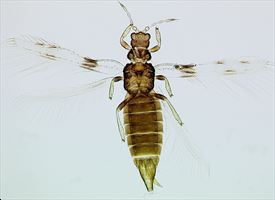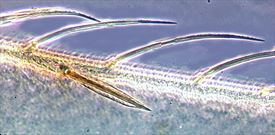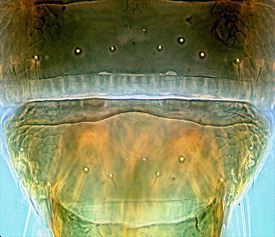Distinguishing features
Both sexes fully winged. Female brown, tibiae and tarsi yellow, also antennal segments III–V; fore wings with prominent reticulate pattern, dark brown area where first vein fuses to costa, both veins bearing a few long setae. Antennae 7-segmented, III and IV each with simple sense cone. Head constricted at basal neck, dorsal setae broad but translucent. Pronotum with one pair of prominent posteroangular setae, also one pair of anteromarginals and one pair of posteromarginals, these setae flattened with prominent rhachis, as are major setae on the fore wing. Metanotal median setae near posterior margin. Tergites and sternites with broad craspedum; tergites with no sculpture medially, median setae minute.
Male similar to female; tergite IX with no strong setae; sternites IV or V–VII with large pore plate.
Related species
Only one species is known in this genus, and the broad reticulate fore wings with broadly flattened setae are unique amongst Thripidae.
Biological data
Adults and larvae usually on mature leaves rather than young leaves. Found on many different plant species, particularly Kentia palms, but other records include plants as diverse as Ficus species (Moraceae) and Emilia sonchifolia (Asteraceae), also the fern Adiantum formosum. In New Zealand, Passiflora edulis is another favoured host plant, but records do not indicate whether in glasshouses or outside.
Distribution data
Widespread around world, and in temperate countries common on plants in domestic environments. The area of origin is not known, but is equally likely to have been Africa or Australia. In New Zealand recorded only from introduced plants (AK, BP, WN / NN). Collected in January, April, June, July, and September. The first recorded specimen was collected at Tauranga (BP) from passionfruit foliage in June 1935 by W. Cottier.
Family name
THRIPIDAE, PANCHAETOTHRIPINAE
Species name
Parthenothrips dracaenae (Heeger)
Original name and synonyms
Heliothrips dracaenae Heeger, 1854: 365
Parthenothrips concolor Uzel, 1895: 172
References
Martin NA (2017) Palm thrips - Parthenothrips dracaenae. http://nzacfactsheets.landcareresearch.co.nz/factsheet/
InterestingInsects/Palm-thrips---Parthenothrips-dracaenae.html
Mound LA, Tree DC & Paris D (2012) OzThrips – Thysanoptera in Australia. http://www.ozthrips.org/
zur Strassen R (2003) Die terebranten Thysanopteren Europas und des Mittelmeer-Gebietes. Die Tierwelt Deutschlands 74: 1–271.





